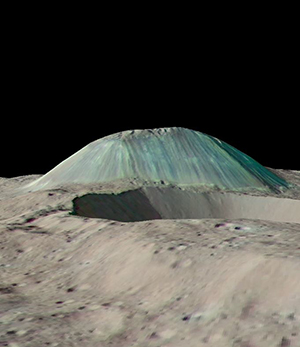When scientists got their first close-up glimpse of Ceres in 2015, they expected to find a large, inert rock orbiting along with the millions of other inert rocks in the asteroid belt. What they did not expect was evidence of geologic activity on the dwarf planet’s dark surface.
In a suite of six papers published today in Science, scientists from the Dawn mission that has a spacecraft circling Ceres catalog a bounty of surface features pointing to one conclusion: “Ceres appears to be geologically active,” said Carol Raymond, the mission’s deputy principal investigator. The Dawn spacecraft entered Ceres’s orbit in March 2015.
Volcanic Ice
One of these surface features is a 17-kilometer-wide, 4-kilometer-high volcano that once erupted ice. This “cryovolcano” rises half the height of Earth’s Mount Everest in the Himalayas.

The researchers spotted the cryovolcano using Dawn’s Framing Camera, which took images of 99% of the dwarf planet’s surface. The feature’s angled slopes with flow-like structures and convex summit are reminiscent of lava domes on Earth, said Ottaviano Ruesch, a postdoctoral researcher at NASA’s Goddard Space Flight Center and lead author on the paper detailing the feature. He compared it to a lava dome found in Washington State’s Mount St. Helens volcanic crater. Although features of cryovolcanic origin have been spotted on other bodies in the solar system, the newly named Ahuna Mons on Ceres stands out as the first observed cryovolcanic dome, Ruesch said.
On Earth, lava domes form when sticky, viscous, molten rock bubbles slowly to the surface, solidifies, and piles up around the vent. On Ceres, where temperatures average about 160 kelvins (–113°C), volatile, rich, salty water “erupts,” the researchers suggest. The presence of salts on Ceres lowers the freezing temperature of water, said Ruesch. The lowered freezing temperature keeps the water a liquid that slowly rises to Ceres’s surface. There it solidifies and has piled up into a 4-kilometer-high mound.
Although Ahuna Mons is no longer active, by analyzing the number of craters around the feature, scientists estimate that it’s only about 200 million years old, Ruesch said, which is considered geologically young.
Bright Spots
Ceres sports well-known bright spots on its surface—the newly released findings point to these as signs of more geologic activity, Raymond said. The team had already established that Ceres’s bright spots are composed mainly of sodium carbonate, a salt found abundantly at the bottom of Earth’s oceans. Because no crashing asteroid could have brought this material to the dwarf planet, the scientists suspect it rose to the surface from within.

On Earth, we know how magma rises to the surface—the hot interior transfers heat to rock above it, which rises as it becomes more buoyant; meanwhile, colder rocks farther away sink down to be reheated. This process continues until hot, molten rock breaks through the stiff, cold crust.
In a similar fashion, the bright spots may represent patches where brines upwelled, spilled out onto the surface, and dried, leaving the salts behind. But in Ceres’s case, the Dawn team isn’t quite sure how the melted brine moves upward.
“We have, we believe, some partially melted brines at depth,” Raymond said, but “we don’t have an obvious mechanism by which those cryomagmas can get to the surface.”
Impacts and Flows
Evidence for other bursts of geologic activity shows up near impact craters, as detailed in another paper on the dwarf planet’s geomorphology.
On a geologically inactive world, an impact would hurl material upward that would then settle down around the crater. But on Ceres, features in the vicinity of many impact craters suggest that material flowed for many tens of kilometers, indicating that the crust contains some ice, which melted from the crash of an incoming meteor.
The researchers spotted many extensive examples of such impact-induced flow that lasted longer than would be expected on an inert world, said Chris Russell, Dawn’s principal investigator.
Landslides also appear to occur on Ceres, as evidenced by the team’s discovery of surface water ice on the steep slopes inside a crater called Oxo. Dawn data suggest that a pliable, ice-rich layer lies underneath the stiffer, rocky surface. Because ice would sublimate from an inert planet’s surface within roughly a century, finding exposed ice raises the possibility that a series of landslides or very slow slippage of the surface is currently exposing fresh ice.
“We have no idea how long [the landslide] has been active,” Russell said. But the fact that Dawn scientists see ice suggests that the process is ongoing, he noted.
A Dynamic World
The team expected to find a completely cooled-off, geologically dead world, with possible features of past activity, Raymond said.
“Finding evidence for ongoing activity is surprising,” she continued, “and it’s clearly giving us a lot to think about in terms of how this body works.”
—JoAnna Wendel, Staff Writer
Correction, 27 February 2017: An earlier version of this article incorrectly described the shape of a surface feature and mistakenly mentioned air. The article has been updated to eliminate the errors.
Citation:
Wendel, J. (2016), New findings suggest dwarf planet Ceres is geologically active, Eos, 97, https://doi.org/10.1029/2016EO058611. Published on 01 September 2016.
Text © 2016. The authors. CC BY-NC-ND 3.0
Except where otherwise noted, images are subject to copyright. Any reuse without express permission from the copyright owner is prohibited.

